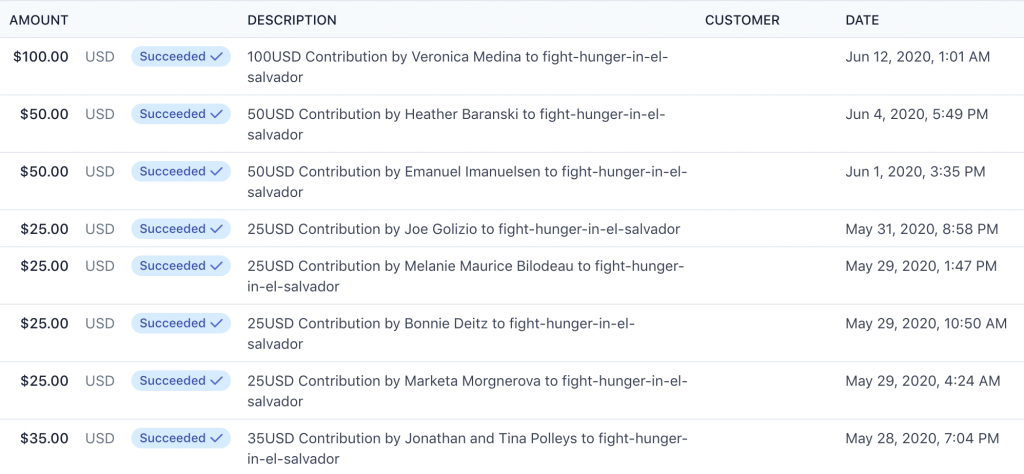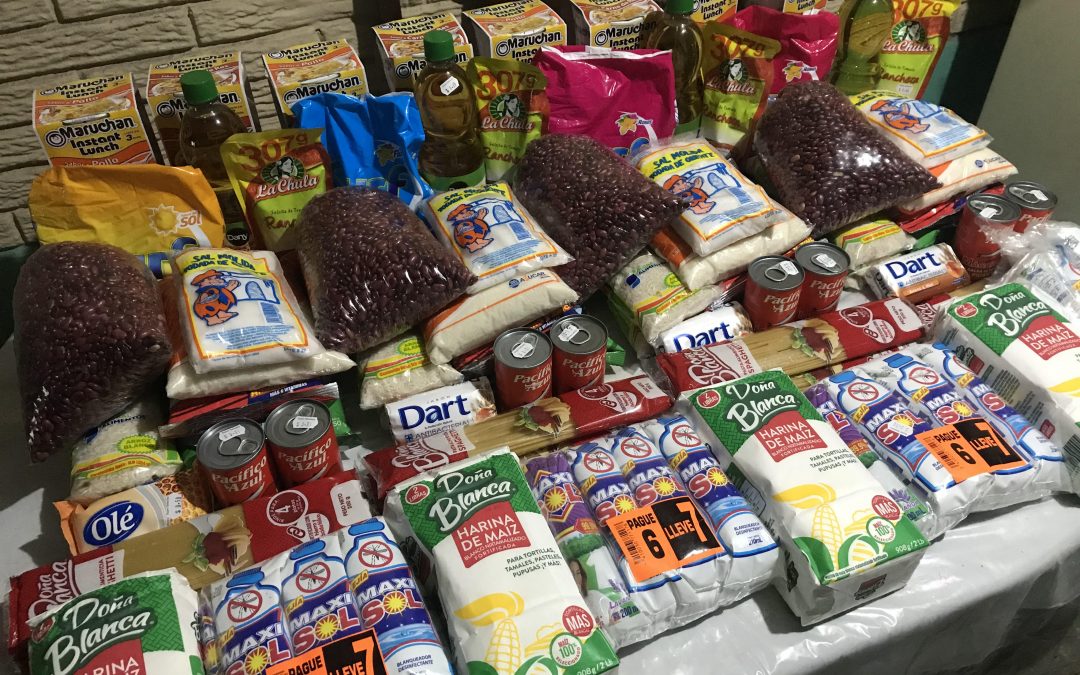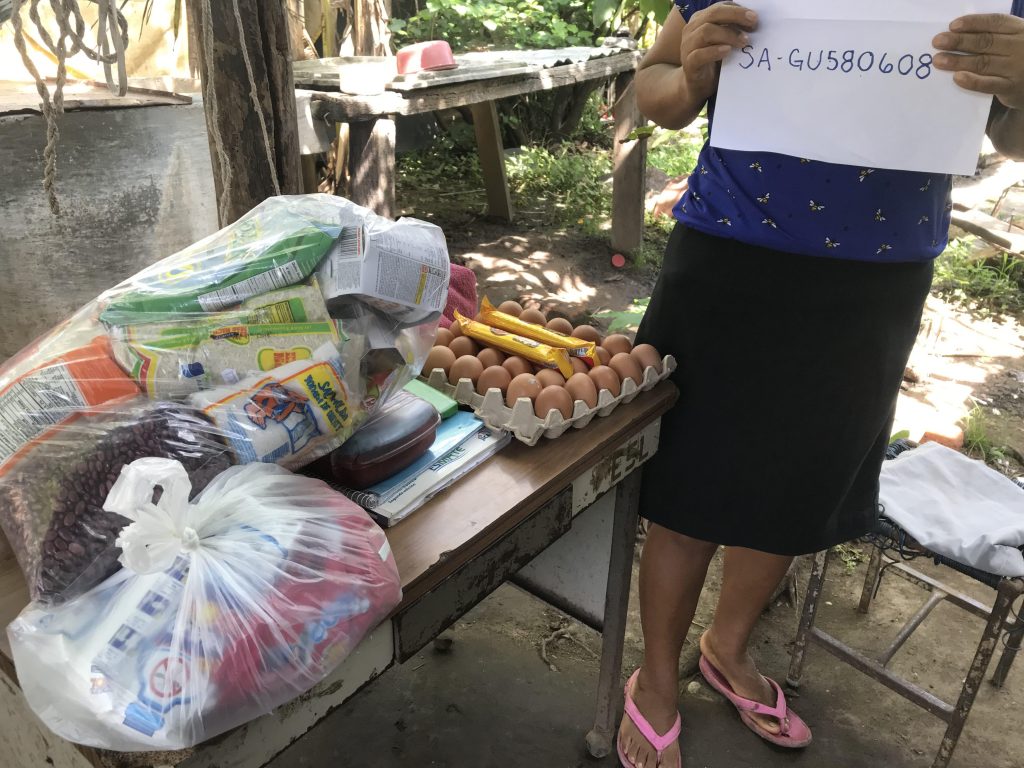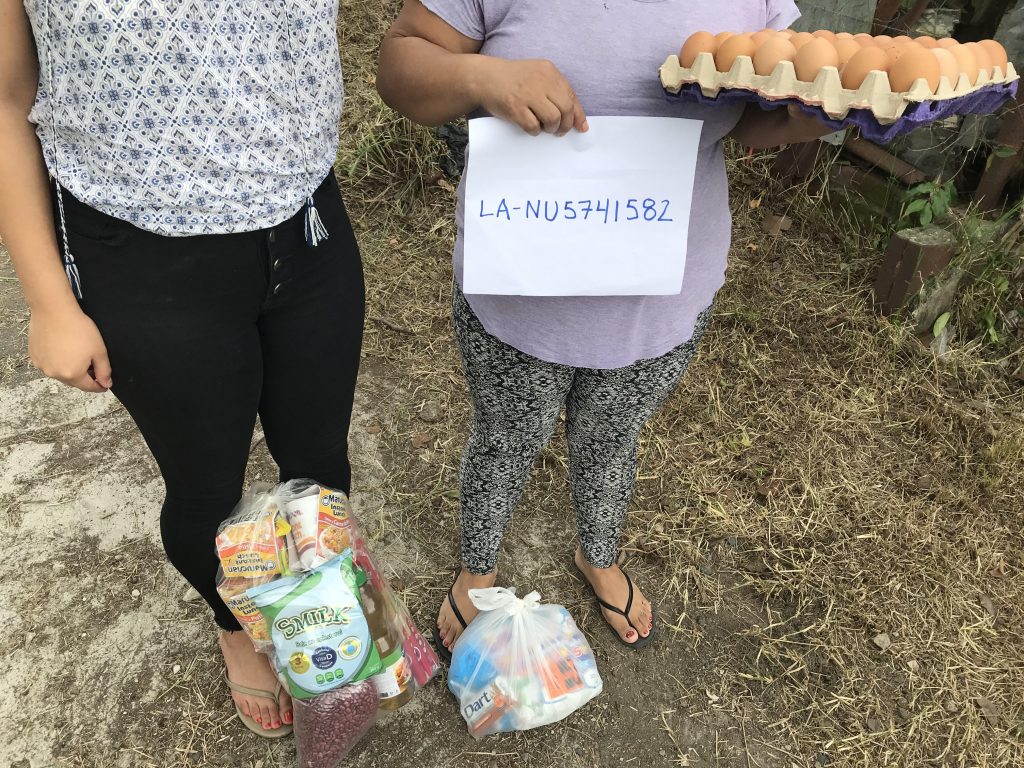We have a lot of great news! So much has happened over the last few days. Our micro-campaign, Fight Hunger In El Salvador has a lot of great things in motion.
Three days ago, on June 11th, we received our first campaign distribution from Stripe, the payment processor for Fundly. Since then, we’ve purchased food (shown above) and distributed it to 3 families, with a 4th family pending.
If you’re not aware of our campaign story, please read Famine Flags Are Hanging As Covid19 Starvation Crisis Begins and consider contributing to our effort. We are working hard to help families that need food in El Salvador. Every dollar helps and we greatly appreciate everyone’s support.
A Recap Of The Past Few Days
June 11th – We received the first $235 distribution from Stripe.
June 12th – We calculated how much food to purchase, which was more difficult than it sounds. Fortunately Stephanie’s mother is well versed on which staple foods are post important for Salvadoran families (and the quantities/costs associated with each). So I put together a spreadsheet (below) and we made a detailed list. Then we tested purchasing $100 of food for 4 families in order to determine the exact cost of food per family. Finally, we separated it into large transparent bags.
Also on June 12th, Stephanie found an online service: ayuda-sv.org. “Ayuda” means “help” and “sv” is the abbreviation for El Salvador. This website helps us identify those that need food, allows us to communicate directly with them and bring it directly to their doorsteps.
June 13th – We distributed the first 3 bags of food to families. We drove to 3 different towns near us. A fourth family reached out to us that they need help, so we held the 4th bag of food for them, which is still waiting to be picked up.
Here are photos of the people that we’ve helped so far:
Note, I didn’t take photos of their faces in order to respect their privacy.
An Action Plan With Small Hurdles
After receiving the initial funds, Stephanie and I put together an action plan of how we’ll purchase the food and how it will be distributed. I’ve been cautious because we need to utilize the money as efficiently as possible to help the largest number of people.
This has been a crash course in just about every way possible. From raising funds to purchasing food to distributing the food, we’ve learned so much.
Challenge #1: Whom to give food.
A big challenge that we’ve faced is identifying who needs food the most and how to give it to them. At this point, there are thousands of people that need help and it’s sometimes overwhelming trying to handle these decisions.
Every time we drive in our car, we are seeing more and more white hunger flags. And now small groups of people sometimes now go directly into the street waving hunger flags. And that creates challenges. We’d all love to image that we can back-up a large pickup truck of food and unload hundreds of food crates to feed families. And without doubt, that is what’s necessary. But we have a small car, limited money and limited food to offer.
While looking for answers Stephanie found the website Help El Salvador, where Salvadorans write about their need for food, then people with food respond directly to their message and deliver food directly to them. This is what we’ve used and it’s been incredibly helpful to us in the process.
Challenge #2: Deciding what to give each family.
It’s of no help to anybody if we give a bottle of cooking oil to one person and a bag of corn mix to another person. People need a mix of food supplies in order to sustain for a while. Therefore, deciding what to purchase and how to organize the packages is something we’ve handled very methodically.
Stephanie’s mother, Maritza, is Salvadoran and has been very valuable in this part of the process. She cooks Salvadoran food and knows which food products are common and necessary to purchase.
For example, Stephanie and I both thought that “cans of tunafish” would be beneficial to the packages. Maritza explained to us that tunafish is not a common food item in remote areas of El Salvador and that many families will not know how to prepare various meals with cans of tunafish. However, she explained that canned sardines are a different story: Salvadorans know how to utilize sardines more efficiently in cooking.
Also, regarding vegetables – I was surprised to learn that vegetables are perhaps not the best item to purchase for families. The reason being is that vegetables are already somewhat plentiful and readily available in communities at a low price (people already have some level of access to them), plus vegetables have a shorter shelf-life. However, rice, beans, corn mix and cooking oil are more costly, less accessible, retain a longer shelf-life and permit people to cook a larger variety of foods.
Challenge #3: Accepting that we can’t help everybody.
There’s a delicate balance between us accepting that we cannot help everyone, while still trying to help the most people possible.
Honestly, sometimes the situation down here is rather emotionally heavy. There’s a lot of desperation and we hear people’s struggles in the stories that they tell. It’s hard to be at the center of this and unable to help everyone. In one example, today we gave food to a mother and daughter that are struggling. We’ll refer to the mother as “Rose” in the interest of her privacy.
Rose was very kind during our visit. She’s unmarried, about 50 years old, and provides for her young daughter that’s taking high-school classes online. Rose invited us into her humble home where she explained many of the challenges that she faces.
Rose was forced to stop working in February because she was a “non-essential worker”. Since then, she hasn’t paid her $35/monthly rent and her food supplies have dwindled down to nothing. Without food, work and money, Rose grew desperate and posted messages online for help. We were the first to respond. She’s four months behind on her bills and her landlord is starting to press her for rent money.
Fortunately, Stephanie and I can help Rose and her daughter and we are very blessed to be able to help. The small income from our businesses permits us to offer additional help beyond this campaign. But our biggest burden is realizing that we cannot help everyone. It’s difficult. We are doing everything that we can. And we are very appreciative to our supporters because they help us to feed many people that would otherwise go hungry.
A look At How Money Is Being Spent
In total, we’ve received $335 from our micro-campaign “Fight Hunger In El Salvador“. Of that money, we’ve received $235 in distributions from Stripe. In other words, we are still waiting on $100 to be transferred to us:

Also, we’ve spent exactly $85.70 of the money that we’ve received. That $85.70 was used to purchase food, soap and bleach for 4 families. The food will last each family for approximately 1-2 weeks depending on their family size and how well they ration the food.
Our goal to keep costs down have been successful. We purchase eggs, rice and beans in large quantities, which lowered our cost per unit.
As I mentioned, Stephanie’s mother Maritza has been incredibly helpful in our small campaign. Maritza has experience working in fundraising for her local church and she knows exactly what people need to get through these difficult times. Maritza herself purchased the food from three different local markets and she kept detailed records of the money that she spent.
Some of Maritza’s great suggestions were soap, laundry detergent and bleach. My initial plan didn’t include these things because I was focussed purely on food. But Maritza pointed out that bleach is used to sanitize and that hygiene is particularly important during this pandemic, considering the existing threat of coronavirus. I had overlooked that important part.
Purchasing More Food
Now that we understand the process, we can amplify our efforts. Our initial test was buying food for 4 families with a budget of $100. We managed to spend $21.43 per family ($85.70 divided by 4). With that, we can now scale our operation and repeat the process again and again.
I’ve put together a spreadsheet that outlines the detailed prices and quanities of food that we purchase for each family. You can see the spreadsheet here:
Google Sheet: Estimated Food Costs & Quantities
Now we know exactly which foods to purchase, the quantities of food to purchase and the optimal method for safely delivering food to those with need. Those things were very important for us to learn.
For our next food purchase, we’ll double our purchase and buy food for 8 families. And we know that it’ll cost exactly $171.44 – which is $21.43 x 8 families.
We’re currently waiting for our next free moment to purchase more food. Keep in mind that all of this is happening with the extra time that we have. Stephanie is running her veterinary clinic and I am doing computer work for my online clients.
So, we must maintain a reasonable balance between sustaining ourselves through work, fundraising efforts, purchasing and bundling the food, communicating with those in need, delivering the food and keeping our supporters updated on what’s happening. It’s a lot to manage and we’re very blessed to be in a position to be able to do all of this.
Food Items In Each Package/Bundle
In our food cost spreadsheet (mentioned above), we include the following foods in each family bundle:

The image above doesn’t include the eggs or chocolate which is handled seperately.
Here’s everything on the list:
- Beans – 2 Pounds
- Rice – 2 Pounds
- Eggs – 30 Eggs
- Cooking oil – 1 Bottle
- Corn flour – 2 Pounds
- Sugar – 2 Pounds
- Salt – 1 Pound
- Powdered milk – 1 Pound
- Incaparina – 1 Pound (A powdered drink common to El Salvador)
- Sardines – 2 Cans
- Spaghetti – 2 Packages
- Tomato sauce – 1 Package
- Instant noodles – 4 “Cups”
- Chocolate – 2 Bars
Non-food items:
- Soap – 1 Large Bar
- Laundry Detergent – 1 Bag of Powdered Detergent
- Bleach – 7 Plastic Capsules (Bleach often comes in plastic capsules in El Salvador)
We’ve considered purchasing chicken but we couldn’t justify it. Meat is more expensive. It doesn’t make sense for one family to have chicken and another family to have nothing. So, we purchased eggs, sardines and beans as the primary sources of protein.
Eggs in particular are very common and valuable in Salvadoran meals. Another advantage is that eggs don’t need to be frozen, which may be important for families that cannot afford the cost of refrigeration/electricity. Also, eggs here come from local farms and do not need to be refrigerated.
Progress With The News Media
One of my initial complaints in reference to the hunger facing Latin America was specifically towards the news media’s lack of coverage. It was frustrating. These hunger flags were going up everywhere and no english-speaking news sources were covering the story. Fortunately, that has changed somewhat.
On May 17th, I published my original article covering the white flags. Immediately after publishing my article, I Twitter-bombed the big news media outlets and received more than 1,000 reader impressions:
The streets of El Salvador are filling up with #FamineFlags – People desperately need food and water.@CNNEE @washingtonpost @NewYorker @nytimes @MSNBC @BreitbartNews @CNBC @businessinsider @ABC @freezerohedge @CNN @AP @NewsHour @NPR @CBSNews @Reuters @foxnews @Bloomberg https://t.co/ABogxwncjV
— ImperfectPlan (@PlanImperfect) May 18, 2020
I also had the support of Emanuel and Liv Imanuelsen that live in Sweden, whom helped generate awareness on Twitter and have contributed to our effort, all of which we am very grateful (thank you!).
Within a week, the story received some decent coverage:
May 18 – Aljazeera: El Salvador Supreme Court orders state of emergency suspended
May 21 – Reuters: As hunger spreads under lockdown, Guatemalans and Salvadorans raise white flag
May 22 – The Guardian: Guatemala’s white flags indicate pandemic’s deadly side-effect: hunger
May 27 – Associated Press: UN: Virus could push 14 million into hunger in Latin America
That’s all of the news coverage that El Salvador received from the mainstream media. At least it’s something. I don’t know why they didn’t cover it sooner. Local Salvadoran news was covering it for two weeks before the english-speaking news media would cover it.
Thank You To Our Supporters
I cannot thank everyone enough. You are literally saving lives.
When we deliver the food to people, their words and facial expressions are so grateful that we are willing to help them, that you are willing to help them. It’s like they come to life with a new positive energy to push forward, which is something that they need so much. The mothers in particular have a big burden lifted from their shoulders.
Stephanie is very good at communicating with them, uplifting their spirits and ensuring that their needs are met. Without doubt, this is a team effort.
You are the supporters that make this effort possible. People are eating today that otherwise would not have food. We thank you very much.
We will continue providing updates as we make more progress.
For any new supporters, please use the link below to donate to our campaign:
Thank you!





